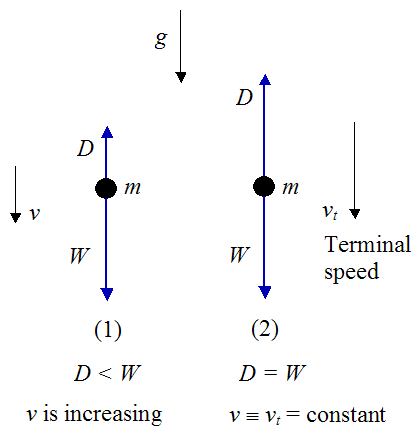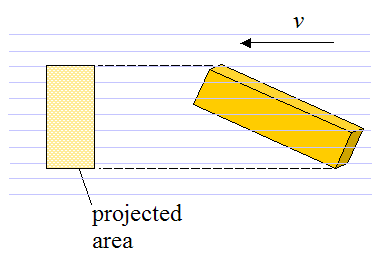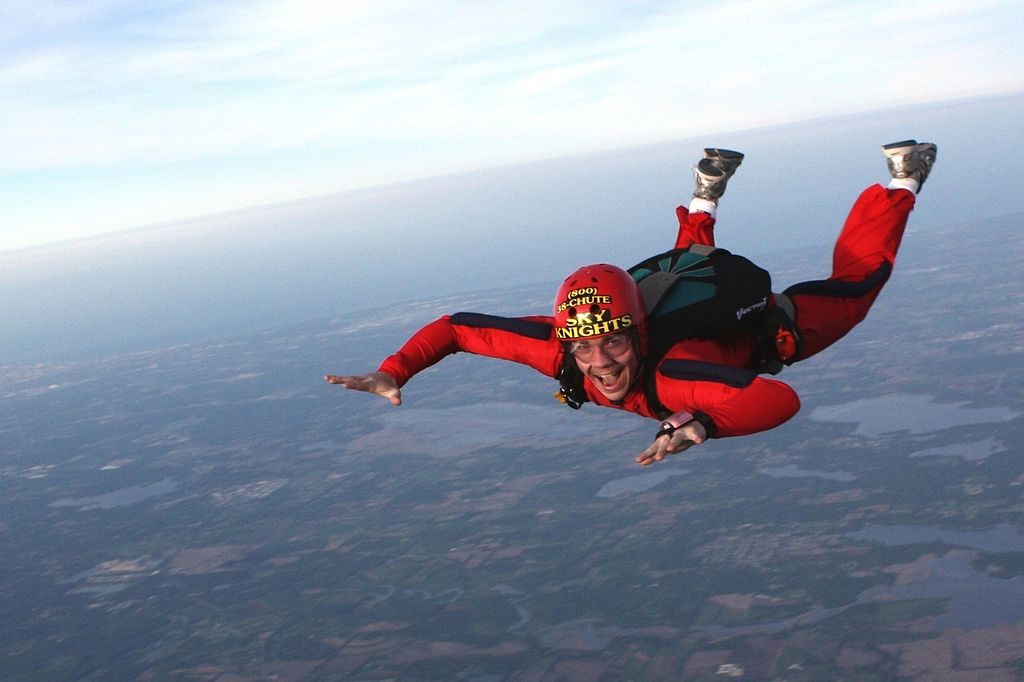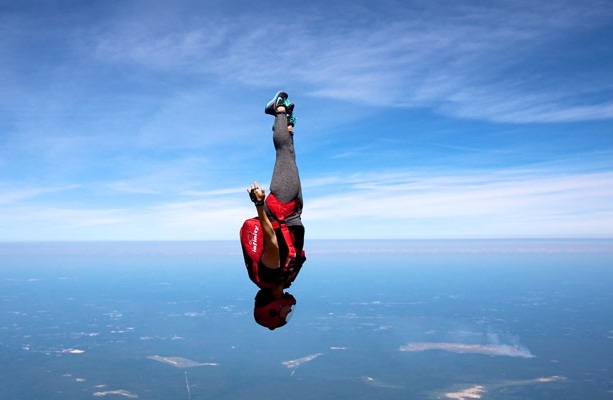The Physics Of Skydiving – Terminal Speed
The physics behind skydiving involves the interaction between gravity and air resistance. When a skydiver jumps out of a plane he starts accelerating downwards, until he reaches terminal speed. This is the speed at which the drag from air resistance exactly balances the force of gravity pulling him down. The figure below shows a free-body diagram of this.

Where:
- \(g\) is the acceleration due to gravity, which is \(9.8\) \(m/s^{2}\)
- \(m\) is his mass
- \(D\) is the drag force acting upwards
- \(W\) is the force of gravity pulling him down
- \(v\) is the speed at which he falls
- \(v_{t}\) is the constant (terminal) speed he reaches when \(D = W\)
It is easy to understand why his speed increases when \(D \lt W\). By Newton's Second Law, \(\Sigma F = ma\), and \(\Sigma F = W − D\), so his acceleration a is positive and therefore \(v\) increases.
The general drag equation for skydiving for drag acting on a body is:
\[D = \frac{1}{2}C\rho Av^{2}\]
Where:
- \(C\) is the drag coefficient, which can vary along with the speed of the body. But typical values range from 0.4 to 1.0 for different fluids (such as air and water)
- \(\rho\) is the density of the fluid through which the body is moving (in this case, the fluid is air)
- \(v\) is the speed of the body relative to the fluid
- \(A\) is the projected cross-sectional area of the body perpendicular to the flow direction (that is, perpendicular to \(v\)). This is illustrated in the figure below

The force of gravity pulling the skydiver down is:
\[W = mg\]
When terminal speed is reached D = W so we have equation for terminal speed for skydiving
\[mg = \frac{1}{2}C\rho A v_{t}^{2}\]
Solving for terminal speed \(v_{t}\) we have the terminal speed for skydiving
\[v_{t} = \sqrt{\frac{2mg}{C\rho A}}\]
An important observation is that, the smaller the cross-sectional area A, the higher the terminal speed. So if a skydiver wants to catch up to his fellow skydiver, he can do that by decreasing his A value. One way to do that is to re-orient your body so that your head is facing down.


The mass of the object is also an important factor. A feather will fall much more slowly than a solid object such as a rock, because the drag force relative to body weight (mg) is much higher for a feather.
A skydiver typically reaches speeds of around 120 mph in the spread-eagle position (shown in the first figure). But he can reach speeds up to 200 mph if he orients his body with head pointing down, thereby decreasing A.
During free-fall a skydiver can perform a variety of acrobatic maneuvers such as spinning, moving forward, moving backward, just by changing the shape of his body to "catch" the wind a certain way. By doing this he is essentially changing the direction of the drag force acting on his body, much the same way airplane wings can be oriented to produce a desired motion for the plane.
The final drag force the skydiver must experience is from releasing his parachute, which slows his descent enough for him to land safely.

Parachutes were invented about a century ago, but they continue to evolve, as inventors devise ever-better ways to improve their safety and handling. Here's a more advanced 'chute, designed for the US Army in 2001 (and patented in 2003). It contains the same basic features as other chutes: a canopy (10, blue), a skirt underneath (12), and suspension lines (14) in four groups called risers (16), attached to a bridle (22), which supports the harness (26) and parachutist (P). But it also has two improved safety features to reduce the risk of the parachutist landing too fast and too hard. At the top, the parachute has a bridle with an extra loop of rope on either side and an electrical cutting mechanism to release it (pink, top, labeled 28). In the middle, it has what's known as a pneumatic muscle (bright green, 24). There's an altitude measuring device (gray, top, 34, 36, 44), which projects radar beams to the ground to measure your height and speed and figure out when the safety mechanisms need to be deployed.


If the wind blows you too fast horizontally, the appropriate electrical mechanism releases one of the extra side ropes, causing the parachute to tilt to the opposite side, so reducing your speed. When you near the ground, if you're going too fast, the pneumatic muscle shortens, pulling you much closer toward the canopy, and so reducing your speed.
Parachute dramatically lowers your terminal velocity by increasing your air resistance as you fall. It does that by opening out behind you and creating a large surface area of material with a huge amount of drag. Parachutes are designed to reduce your terminal velocity by about 90 percent so you hit the ground at a relatively low speed of maybe 5–6 meters per second (roughly 20 km/h or 12 mph)—ideally, so you can land on your feet and walk away unharmed.

Traditionally, parachutes were round (dome-shaped) and, with their dangling suspension lines, looked a bit like jellyfish as they fell. They had vent holes that allowed air to escape, which helped to prevent them from rocking about as they came down, and their lines provided very basic steering.
Most modern parachutes are rectangular (a design known as ram-air). They have a number of cells that inflate as the air "rams" into them, so they form a fairly rigid, curved airfoil wing, which is much more steerable and controllable than a dome-shaped parachute.
Rounder chutes are still widely used by military paratroopers, because they work well for dropping lots of people together, in a fairly small area, at relatively low altitudes; paratroopers are simply trying to get to the ground quickly, not show off their skydiving technique. Recreational divers, on the other hand, consider round chutes obsolete: virtually all of them now use the ram-air design instead.